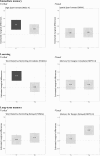Transferability of an executive function intervention in children with cerebral palsy: A randomized controlled trial
- PMID: 39258948
- PMCID: PMC11875527
- DOI: 10.1111/dmcn.16057
Transferability of an executive function intervention in children with cerebral palsy: A randomized controlled trial
Abstract
Aim: To evaluate the transfer effects of a home-based computerized executive function intervention on non-targeted cognitive functions (visual perception and memory), quality of life (QoL), and participation in children with cerebral palsy (CP), and to determine whether any improvements were maintained 9 months after the intervention.
Method: Sixty children with CP (aged 8-12 years) were randomly allocated to the intervention (15 females/15 males, mean age 10 years 4 months [SD = 1 years 8 months], age range 8-12 years) or waitlist (control) (15 females/15 males, mean age 10 years [SD = 1 years 9 months], age range 8-12 years) group. The intervention group underwent a home-based executive function intervention programme for 30 minutes per day, 5 days a week, for 12 weeks. All participants were assessed before the intervention, immediately after and 9 months after the intervention was completed.
Results: After the intervention was completed, performance in immediate verbal memory, verbal learning, and visual perception (object and picture recognition) was significantly better in the intervention group than in the waitlist (control) group. No improvements were found in visual memory, visuospatial perception, QoL, or participation after the intervention. Scores at the follow-up showed that any beneficial effects were not maintained 9 months after the intervention was completed.
Interpretation: A home-based computerized executive function intervention produced transfer effects on memory and visual perception immediately after the intervention in children with CP, although any beneficial effects were not sustained at the 9-month follow-up.
© 2024 The Author(s). Developmental Medicine & Child Neurology published by John Wiley & Sons Ltd on behalf of Mac Keith Press.
Figures





References
-
- Rosenbaum P, Paneth N, Leviton A, et al. A report: The definition and classification of cerebral palsy April 2006. Dev Med Child Neurol 2007; 49: 8–14. - PubMed
-
- Ballester‐Plané J, Laporta‐Hoyos O, Macaya A, et al. Cognitive functioning in dyskinetic cerebral palsy: Its relation to motor function, communication and epilepsy. Eur J Paediatr Neurol 2018; 22: 102–12. - PubMed
-
- Fluss J, Lidzba K. Cognitive and academic profiles in children with cerebral palsy: A narrative review. Ann Phys Rehabil Med 2020; 63: 447–56. - PubMed
-
- Gioia GA, Isquith PK, Guy SC. Assessment of executive functions in children with neurological impairment. In: Psychological and developmental assessment: Children with disabilities and chronic conditions. New York, NY, US: The Guilford Press, 2001: 317–56.
Publication types
MeSH terms
Grants and funding
- 1037220/National Health and Medical Research Council of Australia
- PID2020-117163RB-I00/AEI/10.13039/501100011033/Agencia Estatal de Investigación
- 2017SGR0748/Agència de Gestió d'Ajuts Universitaris i de Recerca
- FI-SDUR 2020/Agència de Gestió d'Ajuts Universitaris i de Recerca
- PSI2016-75979-R AEI/FEDER, UE/Ministerio de Economía y Competitividad
LinkOut - more resources
Full Text Sources
Medical
Miscellaneous

